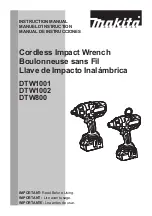
MTS53256
3
Rev. 7/30/21
AIR INLET
OPERATING INSTRUCTIONS
MTS53256
1" DRIVE LIGHTWEIGHT IMPACT
WRENCH WITH EXTENDED ANVIL
POWER MANAGEMENT SYSTEM
AND TOOL OPERATION
This tool includes an adjustable power management system that allows the
operator to adjust power in the clockwise direction (forward) and counter
clockwise direction (reverse).
To set tool up with full power output in forward direction and full power in the
reverse direction; rotate the power dial until the notch on the dial aligns with the
number 5 setting on each side of the tool.
To set tool up with reduced power output in forward direction and full power
in the reverse direction; push the reversing valve out in the clockwise direction
(forward) and adjust the dial to the desired number in the forward direction. You
will see that when the reversing valve is switched back to counter clockwise, the
tool will have full power output.
To set tool up with full power output in forward direction and reduced power in the
reverse direction; push the reversing valve out in the counter clockwise direction
(reverse) and adjust the dial to the desired number in the reverse direction. You
will see that when the reversing valve is switched back to clockwise, the tool will
have full power output.
The power management system is only for reference and does not act as specific
power settings. This tool includes a tip valve variable speed trigger design that
further allows the operator to reduce the power output.
This impact wrench is rated at 1" SAE bolt size. Rating must be down graded
for spring U bolts, tie bolts, long cap screws, double depth nuts, badly rusted
conditions and spring fasteners as they absorb much of the impact power. When
possible, clamp or wedge the bolt to prevent spring back.
Soak rusted nuts in penetrating oil and break rust seal before removing with
impact wrench. If fastener does not start to move in three to five seconds use a
larger size impact wrench. Do not use impact wrench beyond rated capacity as
this will drastically reduce tool life.
NOTE:
Actual torque on a fastener is directly related to joint hardness, tool speed,
condition of socket and the time the tool is allowed to impact.
Use the simplest possible tool-to-socket hook up. Every connection absorbs
energy and reduces power.
Always turn off the air supply, drain hose of air pressure and detach tool from air
supply before installing, removing or adjusting any part or accessory on this tool,
or before performing any maintenance on this tool.
AIR SUPPLY
Tools of this class operate on a wide range of air pressures. It is
recommended that air pressure measures 90 psig at the tool with the
trigger fully depressed and no load applied to the tool. Higher
pressure and unclean air will shorten tool life and may create a
hazardous condition.
Water in the air line will cause damage to the tool. Drain water from
air lines and compressor prior to running tool. Clean the air inlet filter
screen weekly. The recommended hook-up procedure can be viewed
in Figure 1.
The air inlet (Figure 2), used for connecting air supply, has standard 1/2" NPT
American Thread.
Line pressure should be increased to compensate for unusually
long air hoses (over 25 feet). Minimum hose diameter should be 1/2" I.D. and
fittings should have the same inside dimensions.
Ensure an accessible emergency shut off valve has been installed in the air supply
line and make others aware of its location.
TROUBLESHOOTING
Other factors outside the tool may cause loss of power or erratic action. Reduced
compressor output, excessive drain on the air line, moisture or restrictions in air
pipes or the use of hose connections of improper size or poor conditions may
reduce air supply. If outside conditions are in order, and the tool still performs
erratically, disconnect tool from hose and take tool to your nearest Myers Tire
Supply authorized service center.
LUBRICATION & MAINTENANCE
Lubricate the tool daily with a high quality air tool oil. If no air line oiler is used,
run 1/2 ounce of oil through the tool. The oil can be squirted into the tool air
inlet Figure 2, or into the hose at the nearest connection to the air supply, then
run the tool. A rust inhibitive oil is acceptable for air tools.
WARNING: After an air tool has been lubricated, oil will discharge through the
exhaust port during the first few seconds of operation. The exhaust port must
be covered with a towel before applying air pressure to prevent serious injury.
Drain Daily
Regulator
Oiler
Quick Coupler
Leader
Hose
Nipple
Do Not Install
Quick Coupling
Here
Nipple
Filter
Air Supply
Whip Hose
fig. 1
fig. 2




























